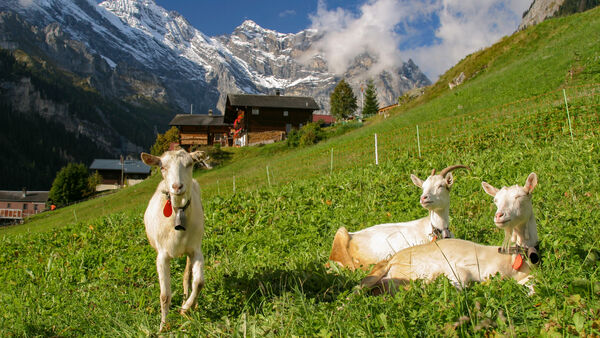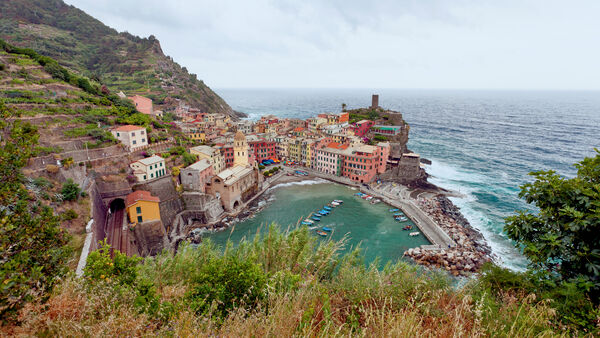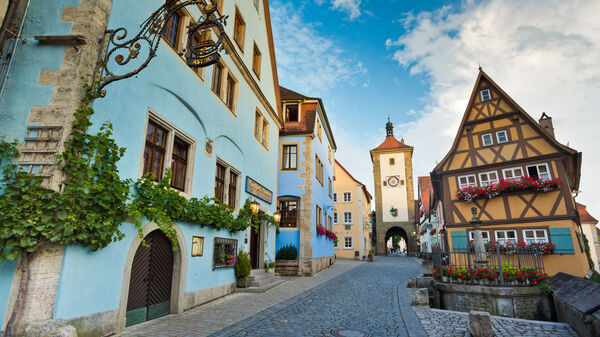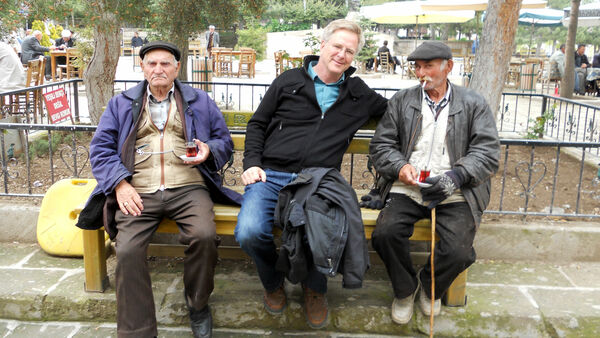Revisiting My Favorite Back Doors, 40 Editions Later





By Rick Steves
I'm celebrating the 40th edition of my first book, Europe Through the Back Door. The first part of ETBD focuses on travel skills. But the back half is all about wonderful locations around Europe: my personal descriptions of favorite Back Doors — places off the radar of mainstream tourism. My goal is to inspire other travelers not only to go to these places, but to find their own intimate connections with offbeat corners of Europe.
Below are excerpts of five different Back Doors, from the Swiss Alps to the Italian Riviera to Cappadocia. While the original descriptions were simpler in the first edition (1980), with each edition I'd add color from recent experiences; the versions below are from the late 1990s. Re-reading these today, I can see the richness of the travel fun shining through. And, happily, the magic of Back Doors like these survives in 2024.
Join me on a quick nostalgic visit to five of my favorite Back Doors, with a short comment from 2024 after each one.
Gimmelwald: For the Alps in Your Lap
When told you're visiting Gimmelwald, Swiss people assume you mean the famous resort in the next valley, Grindelwald. When assured that Gimmelwald is your target, they lean forward, widen their eyes, and — with their sing-songy Swiss-German accent — they whisper, "Und how do you know about Gimmelvald?"
The traffic-free village of Gimmelwald hangs nonchalantly on the edge of a cliff high above Lauterbrunnen Valley, 30 minutes south of Interlaken by car or train. This sleepy village has more cow troughs than mailboxes. The songs of birds and brooks and the crunchy march of happy hikers constantly remind you why so many travelers say, "If heaven isn't what it's cracked up to be, send me back to Gimmelwald."
Gimmelwald, an ignored station on the spectacular Schilthorn gondola (of James Bond fame), should be built to the hilt. But, led by a visionary schoolmaster, the farming community managed to reclassify its land "avalanche zone" — too dangerous for serious building projects. So while developers gnash their teeth, sturdy peasants continue milking cows and making hay, surviving in a modern world only by the grace of a government that subsidizes such poor traditional industries.
Gimmelwald is a community in the rough. Take a walk — you can tour it in 15 minutes. Its two streets, a 700-year-old zig and zag, are decorated by drying laundry, hand-me-down tricycles, and hollowed stumps bursting proudly with geraniums. Little-boy-cars are parked next to the tiny tank-tread cement mixers and mini-tractors necessary for taming this alpine environment. White-bearded elves smoke hand-carved pipes and blond-braided children play "barn." Stones called Schindles sit like heavy checkers on old rooftops, awaiting nature's next move. While these stones protect the slate from the violent winter winds, today it's so quiet you can hear the cows ripping tufts of grass.
Notice the traditional log-cabin architecture. The numbers on the buildings are not addresses, but fire insurance numbers. The cute little hut near the station is for storing and aging cheese, not hostelers. In Catholic-Swiss towns, the biggest building is the church. In Protestant towns, it's the school. Gimmelwald's biggest building is the school (two teachers — who share one job, 17 students, and a room that doubles as a chapel when the pastor makes his monthly visit).
Gimmelwald has three families: von Allmen, Brunner, and Feuz. With the 130 townsfolk sharing three surnames, there are probably 10 Hans von Allmens and a wagonload of Maria Feuzes. To keep prescriptions and medical records straight, the doctor in nearby Lauterbrunnen goes by birthdate first, then the patient's name.
To inhale the Alps and really hold it in, sleep high in Gimmelwald. Poor but pleasantly stuck in the past, the village has a happy hostel, a decent pension, a couple of B&Bs, and the creaky old Hotel Mittaghorn.
Walter Mittler's Hotel Mittaghorn sits at the top end of Gimmelwald. The black-stained chalet has eight balconies and a few umbrellaed tables on its tiny terrace. Everything comes with huge views. Sitting as if anchored by pitons into the steep grassy hillside, the hotel is disturbed only by the cheery chatter of hikers and the two-cycle clatter of passing tractors.
Evening fun in Gimmelwald is found in the hostel (with lots of young Alp-aholic hikers eager to share information on the surrounding mountains); on the Pension Gimmelwald terrace (with the best food in town); and, depending on Walter's mood, at Hotel Mittaghorn. If you're staying at Walter's, enjoy his simple supper and coffee schnapps. Then sit on the porch and watch the sun lick the mountaintops to bed as the moon rises over the Jungfrau.
Rick's Reflections:
By some miracle, Gimmelwald remains much the same as I described it so long ago — thanks to that "avalanche zone" classification. (There still hasn't been a devastating avalanche…but the village has barely changed.)
Reading this, I'm reminded that the door to a deeper connection with such a tradition-rich village is making friends with locals, and talking with them. One major change, however, is that Walter Mittler is no longer running his hotel. Walter carried on far longer than anyone might have imagined — well into his 90s, with help from a mountain-loving expat. Sadly, Walter died in his kitchen sometime around New Year's Day in 2020. Walter's hotel is being renovated and, thankfully, the new owner's vision is to keep the spirit of Walter alive…but with much better plumbing.
Cinque Terre: Italy's Fiat-Free Riviera
"A sleepy, romantic, and inexpensive town on the Riviera without a tourist in sight." That's the mirage travelers chase around busy Nice and Cannes. Pssst! The most dream-worthy stretch of the Riviera sleeps just across the border, between Genoa and Pisa. It's Italy's Cinque Terre.
Leaving the nearest big city, La Spezia, your train takes you into a mountain. Ten minutes later, you burst into the sunlight. Your train nips in and out of the hills, teasing you with a series of Mediterranean views. Each scene is grander than the last: azure blue tinseled in sunbeams, carbonated waves hitting desolate rocks, and the occasional topless human camped out like a lone limpet.
The Cinque Terre, which means "five lands," is five villages clinging to this most inaccessible bit of Riviera coastline. Each is a variation on the same theme: a well-whittled pastel jumble of homes filling its gully like crusty sea creatures in a tide pool. Like a gangly clump of oysters, the houses grow on each other. These days the castles, which used to protect the towns from marauding pirates, protect only glorious views. Locals are the barnacles — hungry, but patient. And we travelers are like algae, coming in with the tide.
The hilly Cinque Terre was originally too rugged to develop. Recently, as locals sensed a possible tourist boom, the government declared the region a national park. While there's a huge demand, no one is allowed to build any comfortable hotels. This keeps away the most obnoxious slice of the traveling public…those who need comfortable hotels. But rugged travelers, content to rent a room in a private home or simple pension, enjoy a land where the villagers have almost no choice but to go about their business as if the surrounding vineyards are the very edges of the earth.
Rick's Reflections:
I must have been high on something as I wrote these descriptions…I think it was high on travel, amped up with a suntan and a white-wine buzz.
Like Gimmelwald, these Italian Riviera villages are so amazingly preserved because they were too poor to develop. And then, in modern times, they've been discovered by tourists — and now have plenty of money.
The Cinque Terre has become very touristy. However, because it's a national park, no one can build any comfortable hotels. That's good news, tourists who insist on comfortable hotels have to head to nearby resorts like Portofino, all the while complaining about traffic congestion, high prices, and slow service. Most of these villages still have only simple pensions and private rooms — allowing hardy travelers to enjoy the peace and tranquility early and late in the day.
Salema, on Portugal's Sunny South Coast
"Let's get the cataplanas," said my wife, urging me to try the fish stew at Ze's Carioca Restaurant in Salema.
Overhearing her, Ze came to our table and said, "I have developed a secret recipe for this specialty. If you don't like it, you don't pay."
"What if we don't like anything else we order?" I asked.
"If you don't pay, I break your fingers," Ze said cheerfully.
We ordered the cataplanas. Savoring our meal as we savored one of the last true villages on the Algarve — Salema.
Any place famous as a "last undiscovered tourist frontier" no longer is. But the Algarve of your dreams survives — just barely. To catch it before it goes, find a fringe. It took me three tries. West of Lagos, I tried Lux and Burgano, both offering only a corpse of a fishing village, bikini-strangled and Nivea-creamed. Then, just as darkness turned couples into peaceful silhouettes, I found Salema.
Any Algarve town with a beach will have tourism, but few mix tourism and realism as well as little Salema. It's my kind of resort — an inviting beach with three hotels, lots of quartos (Portuguese bed-and-breakfasts), and four restaurants specializing in fresh fish and vinho verde (green wine). Tucked away where a dirt road hits the beach on Portugal's southwestern tip, Salema is an easy 15-mile bus ride or hitch from the closest train station in Lagos. Don't let the ladies hawking rooms in Lagos waylay you into staying in their city by telling you Salema is full.
Salema has a split personality. Half is a whitewashed old town of scruffy dogs, wide-eyed kids, and fishermen who've seen it all. The other half was built for tourists. With the horn-tooting arrival of the trucks, the parking lot that separates the jogging shorts from the black shawls becomes a morning market. The 1812 Overture horn of the fish truck wakes you at 8 a.m. Then the bakery trailer rolls in steaming with fresh bread, followed by a fruit and vegetables truck, and a five-and-dime truck for clothing and other odds and ends. And, most afternoons, the red mobile post office stops by.
Salema is still a fishing village. Unwritten tradition allocates different chunks of undersea territory to each Salema family. While the fishermen's hut on the beach no longer hosts a fish auction, it provides shade for the old-timers arm wrestling octopi out of their traps. The pottery jars stacked everywhere are traps. The traps are tied about a meter apart in long lines and dropped offshore. Octopuses, looking for a cozy place to set an ambush, climb inside — making their final mistake.
Fishing is important, but Salema's tourist-based economy sits on a foundation of sand. Locals hope and pray that their sandy beach returns after being washed away each winter.
Locals and tourists pursue a policy of peaceful coexistence at the beach. Tractors pull in and push out the fishing boats, two-year-olds toddle in the waves, topless women read German fashion mags, and old men really do mend the nets. British, German, and Back Door connoisseurs of lethargy laze in the sun, while locals grab the shade.
So often tourism chases the sun and quaint folksiness. And the quaint folks can survive only with the help of tourist dollars. Fishermen boost their income by renting spare bedrooms to the ever-growing stream of tan fans from the drizzly north. One year I arrived at 7 p.m. with a group of eight people and no reservations. I asked some locals, "Quartos?" (Rooms?) Eyes perked, heads nodded, and I got nine beds in three homes at $15 per person. Quartos line Salema's main residential street offering simple rooms with showers, springy beds, and glorious Atlantic views.
Rick's Reflections:
I love how these little moments were all scribbled down as they were fluttering through my actual experience. What does a travel writer do? He carries a little notebook and interrupts his travels when serendipity splashes some cultural color into his world by writing it up vividly, right then and there. "I'll break your fingers" — jotted down at the table. The Overture of 1812 waking you up at 8 a.m…jotted down while still in bed at 8 a.m.
Except for rising prices, this Back Door experience is one of those delightful places where the fun I had in 1994 can still be had 30 years later, in 2024, by you.
Rothenburg ob der Tauber
Twenty-five years ago, I fell in love with a Rothenburg in the rough. At that time, the town still fed a few farm animals within its medieval walls. Today its barns are hotels, its livestock are tourists, and Rothenburg is well on its way to becoming a medieval theme park.
But Rothenburg is still Germany's best-preserved walled town. Countless travelers have searched for the elusive "untouristy Rothenburg." There are many contenders (such as Michelstadt, Miltenberg, Bamberg, Bad Windsheim, and Dinkelsbühl), but none holds a candle to the king of medieval German cuteness. Even with crowds, overpriced souvenirs, a Japanese-speaking night watchman, and, yes, even with Schneeballs, Rothenburg is best. Save time and mileage, and be satisfied with the winner.
In the Middle Ages, when Frankfurt and Munich were just wide spots in the road, Rothenburg was Germany's second-largest city, with a whopping population of 6,000. Today it's Europe's most exciting medieval town, enjoying tremendous tourist popularity.
To avoid the hordes of day-trippers, spend the night. In the deserted moonlit streets, you'll risk hearing the sounds of the Thirty Years' War still echoing through turrets and clock towers.
At the Conversation Club, held every Wednesday night at Mario's Altfränkische Weinstube, locals enjoy a weekly excuse to get together, drink, and practice their fanciest English on each other and on visiting tourists.
This evening I meander into the pub through candlelit clouds of smoke and squeeze a three-legged stool up to a table already crowded with Annaliese and her family from the Freise shop.
Annaliese pours me a glass of wine, then pulls a Schneeball (the local powdered doughnut-like "snowball" from a bag. Raising a cloud of powdered sugar as she pokes at the name on the now empty bag, she says, "Friedel is the bakery I explained you about. They make the best Schneeball. I like it better than your American doughnut. Everyday I eat one. But only at this bakery."
Shoving a big doughy ball my way, she says, "You like to eat this?"
I break off a little chunk, saying, "Only a teeny-weeny bisschen."
For years, Annaliese has playfully tried to get me to write good things about Schneeballs. I put Schneeballs (which originated as a way to get more mileage out of leftover dough in a hungrier age) in that category of penitential foods — like lutefisk — whose only purpose is to help younger people remember the suffering of their parents. Nowadays these historic pastries are pitched to the tourists in caramel, chocolate, and flavors unknown in feudal times.
As Annaliese finishes the Schneeball, we share our favorite slang and tongue twisters. But medieval Rothenburg is waiting. I drain my glass of wine and bid a cheery "Tschüss!"
In the night, I find myself alone with Rothenburg. The winds of history polish half-timbered gables. Following the grooves of centuries of horse carts, I head down to the castle garden. From a distance, the roars of laughter tumbling like waves out of biergartens and over the ramparts sound as medieval as they do modern.
Sitting in a mossy niche in the town wall, I finger the medieval stonework. Notching my imaginary crossbow, I aim an arrow into the dark forest that surrounds the city. Even now, it feels good to be within these protective walls.
On the ramparts after dark, I look over a choppy sea of red-tiled roofs to the murky and mysterious moat beyond the wall. The cannons are loaded. Torches illuminate the gory heads of bad guys on pikes that greet visitors at the city gates. With a dash of moonlight and a splash of wine, Rothenburg once again is a crossroads where modern-day travelers meet medieval wayfarers.
Rick's Reflections:
Sadly, Annaliese is no longer with us (and the weekly conversation club is no more). But the fun-loving people of Rothenburg pass the baton from one generation to the next, both to keep their traditions alive and to ensure they thrive on the tourist dollar. Reading through this essay, I'm struck by how a good traveler can go to the most touristy town in Germany and still find a Back Door experience. I'm also reminded that the more context and understanding you bring with you into a travel experience, the more you'll get out of it.
Güzelyurt — Cappadocia Without Tourists
Güzelyurt means "beautiful land." It's best known in Turkey as the town where historic enemies — Greeks, Turks, Kurds, and Bulgarians — live in peace. The town is a harmony of cultures, history, architecture, and religions. Walk down streets that residents from 3,000 years ago might recognize, past homes carved into the rocks, enjoying friendly greetings of merhaba. Scowling sheepdogs, caged behind 10-foot-high troglodyte rockeries, give the scene just enough tension.
Walk to a viewpoint at the far side of town (above the Sivisli church), toward the snowy slopes of the Fuji-like volcano that rules the horizon. Before you is a lush and living gorge. The cliff rising from the gorge is stacked with building styles: Upon the 1,600-year-old church sit troglodyte caves, Selçuk arches, and Ottoman facades. And on the horizon gleams the tin dome of the 20th-century mosque, with its twin minarets giving you a constant visual call to prayer. The honey that holds this architectural baklava together is people.
Put your camera away, shut your mouth, and sit silently in the sounds of 1000 BC. Children play, birds chirp, roosters crow, shepherds chase goats, and mothers cackle. (Ignore that distant motorbike.)
Below you, sleeping in the greens and wet browns of this tide pool of simple living, is the church of St. Gregorius. Built in 385, it's thought by Gregorian fans to be the birthplace of church music, specifically the Gregorian chant. Its single minaret indicates that it's preserved as a mosque today in a valley where people call god Allah.
Who needs three-star sights and tourist information offices? In Güzelyurt, we dropped by the city hall. The mayor scampered across town to arrange a lunch for us in his home. He welcomed us Christians, explaining, "We believe in the four books" — the local way of saying, "It doesn't matter what you call Him, as long as you call Him." He showed us the names of his Greek Christian friends, kept as safe and sacred as good friends could be in his most precious and holy possession, the family Koran bag.
The lady of the house made tea. Overlapping carpets gave the place a cozy bug-in-a-rug feeling. As the lady cranked up the music, we all began to dance like charmed snakes. It was very safe sex until our fingers could snap no more. A small girl showed me a handful of almonds and said, "Buy dem." Badam is Turkish for almond, and this was her gift to me. Enjoying her munchies, I reciprocated with a handful of Pop Rocks. As the tiny candies exploded in her mouth, her surprised eyes became even more beautiful.
The town's name is spelled proudly across its volcanic backdrop. The black bust of Atatürk seems to loom just as high over the small modern market square. The streets are alive with the relaxed click of victorious tavla (backgammon) pieces. The men of the town, who seem to be enjoying one eternal cigarette break, proudly make a point not to stare at the stare-worthy American visitors searching for postcards in a town with no tourism.
Rick's Reflections:
This is a classic example of how culture shock is not something to be avoided, but a good and constructive thing…the growing pains of a broadening perspective. And from the first edition of Europe Through the Back Door, I've been keen on helping Americans get a dose of Islam — which Turkey offers so conveniently and vividly.
Reading through this little essay, I'm impressed by how these cultural wonders survive to this day…hardly changed in 40 editions of ETBD. But only if you can sit down with the imam, dance with new friends, eat strange food, and toss those backgammon dice in a way that makes the clitter-clatter music of people from two different cultures connecting.
By the way, in the spirit of these Back Doors, I wrote a book in 2020 called For the Love of Europe — a collection of my 100 favorite essays over all of my travels. And, like these descriptions of Back Doors, each is a guidebook in disguise…designed to inspire tourists to become travelers and create rich memories to last a lifetime.

